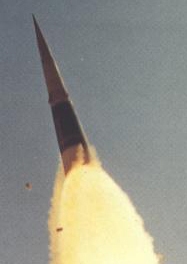Sprint (missile)
| Sprint | |
|---|---|

Sprint missile in flight
|
|
| Type | Anti-ballistic missile |
| Place of origin | United States |
| Service history | |
| In service | 1972 |
| Production history | |
| Manufacturer | Martin Marietta |
| Specifications | |
| Weight | 7,700 pounds (3,500 kg) |
| Length | 26.9 feet (8.20 m) |
| Diameter | 53 inches (1.35 m) |
| Warhead | W66 nuclear low kt |
|
|
|
| Engine | 1st Stage: Hercules X-265 (650,000 pounds-force (2,900 kN); 2nd Stage: Hercules X-271 |
|
Operational
range |
25 miles (40 km) |
| Flight ceiling | 19 miles (30 km) |
| Speed | 12,250 kilometres per hour; 7,610 miles per hour; 3,403 metres per second (Mach 10) |
|
Guidance
system |
Radio command guidance |
|
Launch
platform |
Silo |
The Sprint was a two-stage, solid-fuel anti-ballistic missile (ABM), armed with a W66 enhanced radiation thermonuclear warhead. It was designed to intercept incoming reentry vehicles (RV) after they had descended below about 60 kilometres (37 mi) altitude, where the thickening air stripped away any decoys or radar reflectors and exposed the RV to observation by the radar. As the RV would be travelling at about 5 miles (8.0 km) per second, Sprint had to have phenomenal performance to perform an interception in the few seconds before the RV reached its target.
Sprint accelerated at 100 g, reaching a speed of Mach 10 in 5 seconds. Such a high velocity at relatively low altitudes created skin temperatures up to 6200 °F (3400 °C), requiring an ablative shield to dissipate the heat. The high temperature caused a plasma to form around the missile, requiring extremely powerful radio signals to reach it for guidance.
Sprint was the centerpiece of the Nike-X system, which concentrated on placing bases around large cities to intercept Soviet warheads. As the cost of such a system quickly became untenable as the Soviets added more ICBMs to their fleet, Nike-X was abandoned. In its place came the Sentinel program which used Sprint as a last-ditch defense against RVs that evaded the much longer-ranged LIM-49 Spartan. Sentinel was itself changed to become the Safeguard program, which was operational only for a few months from October 1975 to early 1976. Congressional opposition and high costs linked to its questionable economics and efficacy against the then emerging MIRV warheads of the Soviet Union, resulted in a very short operational period.
...
Wikipedia
